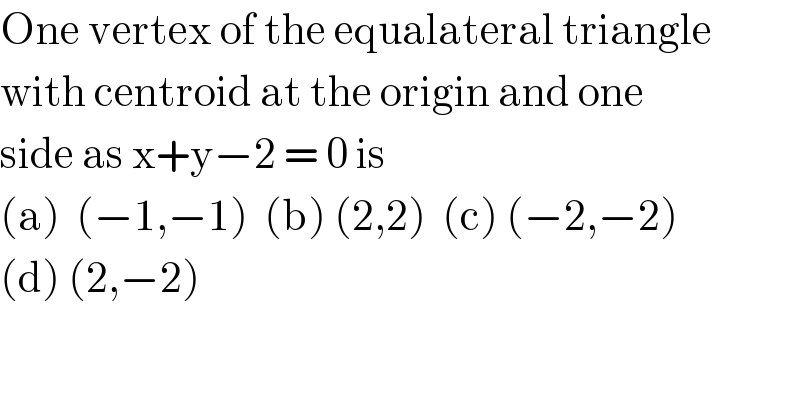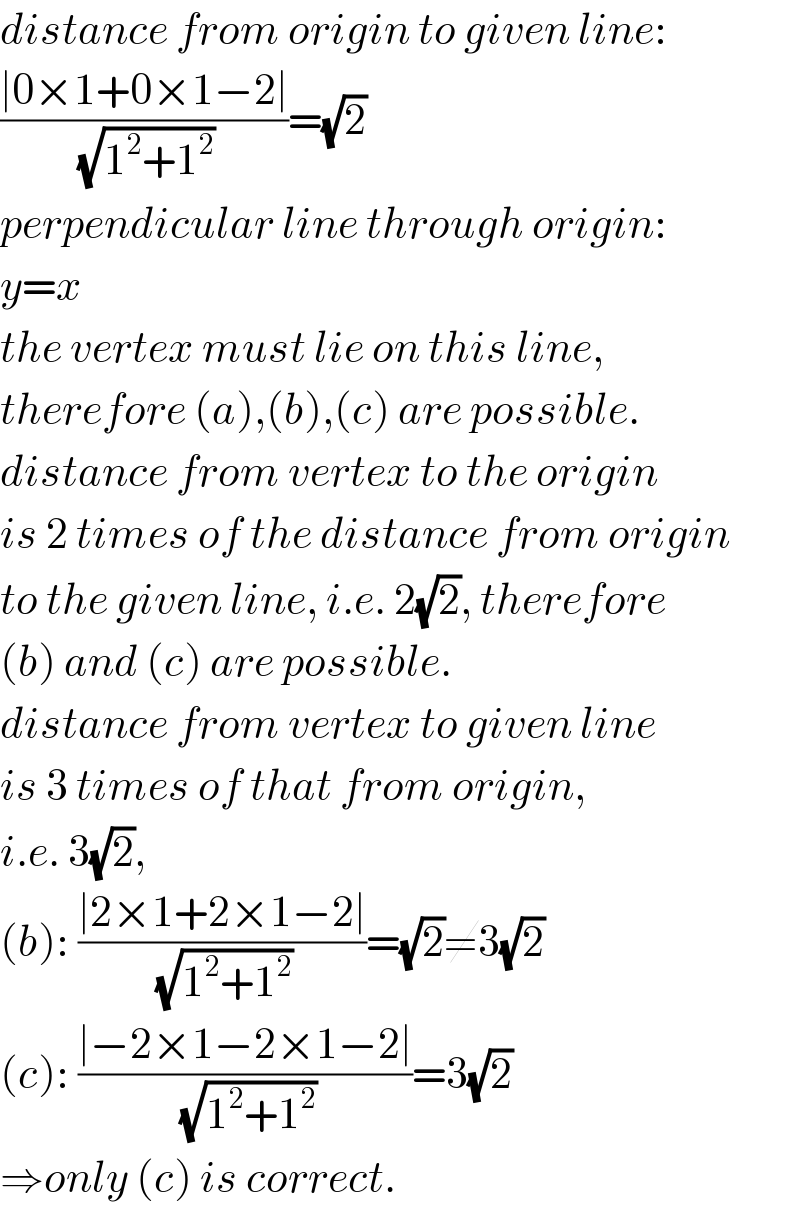Question Number 77000 by vishalbhardwaj last updated on 02/Jan/20

$$\mathrm{One}\:\mathrm{vertex}\:\mathrm{of}\:\mathrm{the}\:\mathrm{equalateral}\:\mathrm{triangle} \\ $$$$\mathrm{with}\:\mathrm{centroid}\:\mathrm{at}\:\mathrm{the}\:\mathrm{origin}\:\mathrm{and}\:\mathrm{one} \\ $$$$\mathrm{side}\:\mathrm{as}\:\mathrm{x}+\mathrm{y}−\mathrm{2}\:=\:\mathrm{0}\:\mathrm{is} \\ $$$$\left(\mathrm{a}\right)\:\:\left(−\mathrm{1},−\mathrm{1}\right)\:\:\left(\mathrm{b}\right)\:\left(\mathrm{2},\mathrm{2}\right)\:\:\left(\mathrm{c}\right)\:\left(−\mathrm{2},−\mathrm{2}\right) \\ $$$$\left(\mathrm{d}\right)\:\left(\mathrm{2},−\mathrm{2}\right) \\ $$
Commented by vishalbhardwaj last updated on 03/Jan/20

$$\mathrm{please}\:\mathrm{tell}\:\mathrm{the}\:\mathrm{correct}\:\mathrm{answer}\:\mathrm{with}\:\mathrm{complete} \\ $$$$\mathrm{explanation}…. \\ $$
Answered by mr W last updated on 04/Jan/20

$${distance}\:{from}\:{origin}\:{to}\:{given}\:{line}: \\ $$$$\frac{\mid\mathrm{0}×\mathrm{1}+\mathrm{0}×\mathrm{1}−\mathrm{2}\mid}{\:\sqrt{\mathrm{1}^{\mathrm{2}} +\mathrm{1}^{\mathrm{2}} }}=\sqrt{\mathrm{2}} \\ $$$${perpendicular}\:{line}\:{through}\:{origin}: \\ $$$${y}={x} \\ $$$${the}\:{vertex}\:{must}\:{lie}\:{on}\:{this}\:{line}, \\ $$$${therefore}\:\left({a}\right),\left({b}\right),\left({c}\right)\:{are}\:{possible}. \\ $$$${distance}\:{from}\:{vertex}\:{to}\:{the}\:{origin} \\ $$$${is}\:\mathrm{2}\:{times}\:{of}\:{the}\:{distance}\:{from}\:{origin} \\ $$$${to}\:{the}\:{given}\:{line},\:{i}.{e}.\:\mathrm{2}\sqrt{\mathrm{2}},\:{therefore} \\ $$$$\left({b}\right)\:{and}\:\left({c}\right)\:{are}\:{possible}. \\ $$$${distance}\:{from}\:{vertex}\:{to}\:{given}\:{line} \\ $$$${is}\:\mathrm{3}\:{times}\:{of}\:{that}\:{from}\:{origin}, \\ $$$${i}.{e}.\:\mathrm{3}\sqrt{\mathrm{2}}, \\ $$$$\left({b}\right):\:\frac{\mid\mathrm{2}×\mathrm{1}+\mathrm{2}×\mathrm{1}−\mathrm{2}\mid}{\:\sqrt{\mathrm{1}^{\mathrm{2}} +\mathrm{1}^{\mathrm{2}} }}=\sqrt{\mathrm{2}}\neq\mathrm{3}\sqrt{\mathrm{2}} \\ $$$$\left({c}\right):\:\frac{\mid−\mathrm{2}×\mathrm{1}−\mathrm{2}×\mathrm{1}−\mathrm{2}\mid}{\:\sqrt{\mathrm{1}^{\mathrm{2}} +\mathrm{1}^{\mathrm{2}} }}=\mathrm{3}\sqrt{\mathrm{2}} \\ $$$$\Rightarrow{only}\:\left({c}\right)\:{is}\:{correct}. \\ $$
